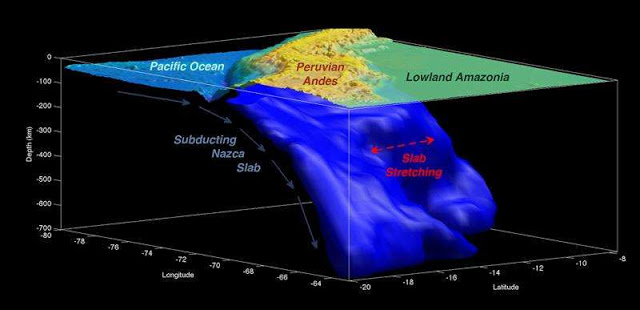
Typically during subduction, plates slide down at a constant rate into the warmer, less-dense mantle at a fairly steep angle. However, in a process called flat-slab subduction, the lower plate moves almost horizontally underneath the upper plate.
The research, published in the journal Nature Geoscience, found that the Earth’s largest flat slab, located beneath Peru, where the oceanic Nazca Plate is being subducted under the continental South American Plate, may be relatively weak and deforms easily.
By studying the speed at which seismic waves travel in different directions through the same material, a phenomenon called seismic anisotropy, the researchers found that interior of the Nazca plate had been deformed during subduction.
Lead author of the study, Dr Caroline Eakin, Research Fellow in Ocean and Earth Science at the University of Southampton, said: “The process of consuming old seafloor at subduction zones, where great slabs of oceanic material are swallowed up, drives circulation in the Earth’s interior and keeps the planet going strong. One of the most crucial but least known aspects of this process is the strength and behavior of oceanic slabs once they sink below the Earth’s surface. Our findings provide some of the first direct evidence that subducted slabs are not only weaker and softer than conventionally envisioned, but also that we can peer inside the slab and directly witness their behavior as they sink.”
When oceanic plates form at mid-ocean ridges, their movement away from the ridge causes olivine (the most abundant mineral in the Earth’s interior) to align with the direction of plate growth. This olivine structure is then ‘frozen’ into the oceanic plate as it travels across the Earth’s surface. The olivine fabric causes the seismic waves to travel at different speeds in different directions, depending on whether or not they are going ‘with the grain’ or ‘against the grain’.
The scientists measured seismic waves at 15 local seismic stations over two and a half years, from 2010 to 2013, and seven further stations located on different continents. They found that the original olivine structure within the slab had vanished and been replaced by a new olivine alignment in an opposing orientation to before.
Dr Eakin said: “The best way to explain this observation is that the slab’s interior must have been stretched or deformed during subduction. This means that slabs are weak enough to deform internally in the upper mantle over time.”
The researchers believe that deformation associated with stretching of the slab as it bends to takes on its flat-slab shape was enough to erase the frozen olivine structure and create a new alignment, which closely follows the contours of the slab bends.
“Imaging Earth’s plates once they have sunk back into the Earth is very difficult,” said Lara Wagner, from the Carnegie Institution for Science and a principal investigator of the PULSE Peruvian project. “It’s very exciting to see results that tell us more about their ultimate fate, and how the materials within them are slowly reworked by the planet’s hot interior. The original fabric in these plates stays stable for so long at the Earth’s surface, that it is eye opening to see how dramatically and quickly that can change,” Lara added.
Reference:
Internal deformation of the subducted Nazca slab inferred from seismic anisotropy, DOI: 10.1038/ngeo2592
Note: The above post is reprinted from materials provided by University of Southampton.










